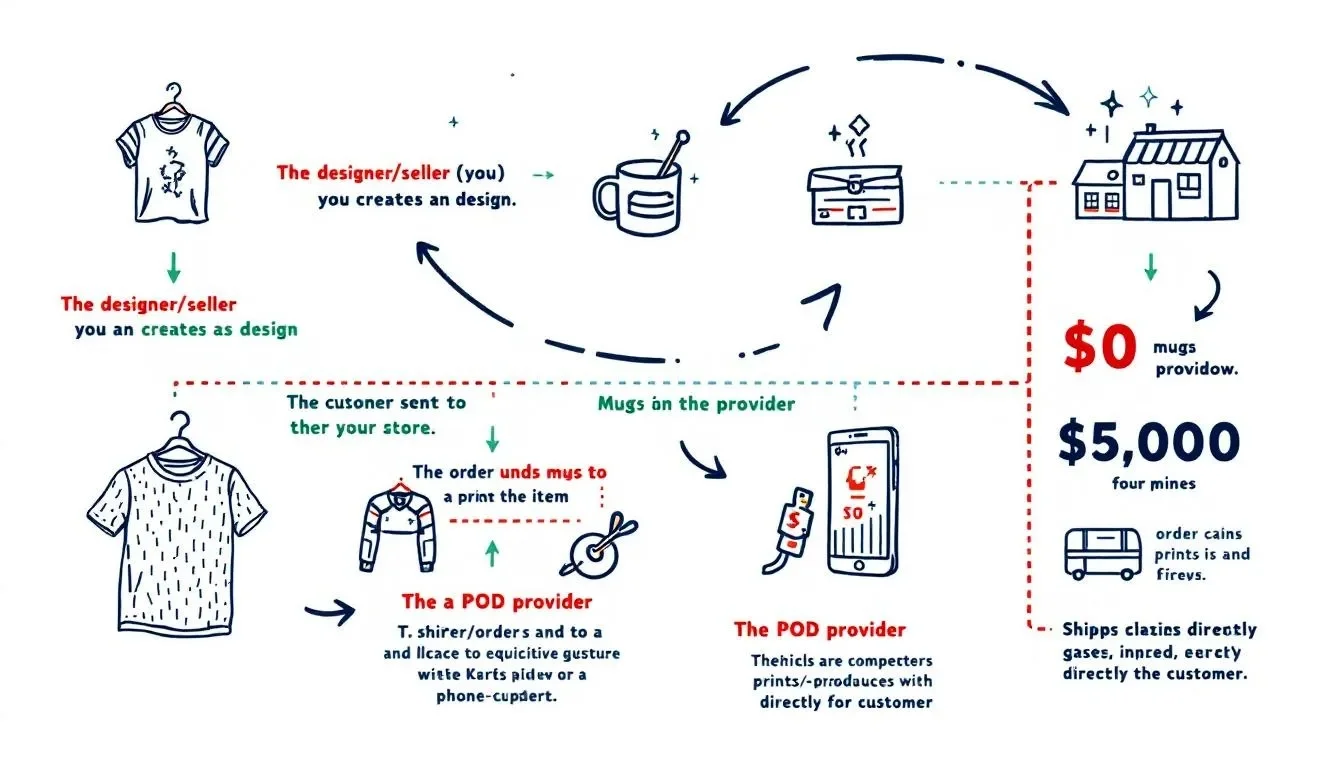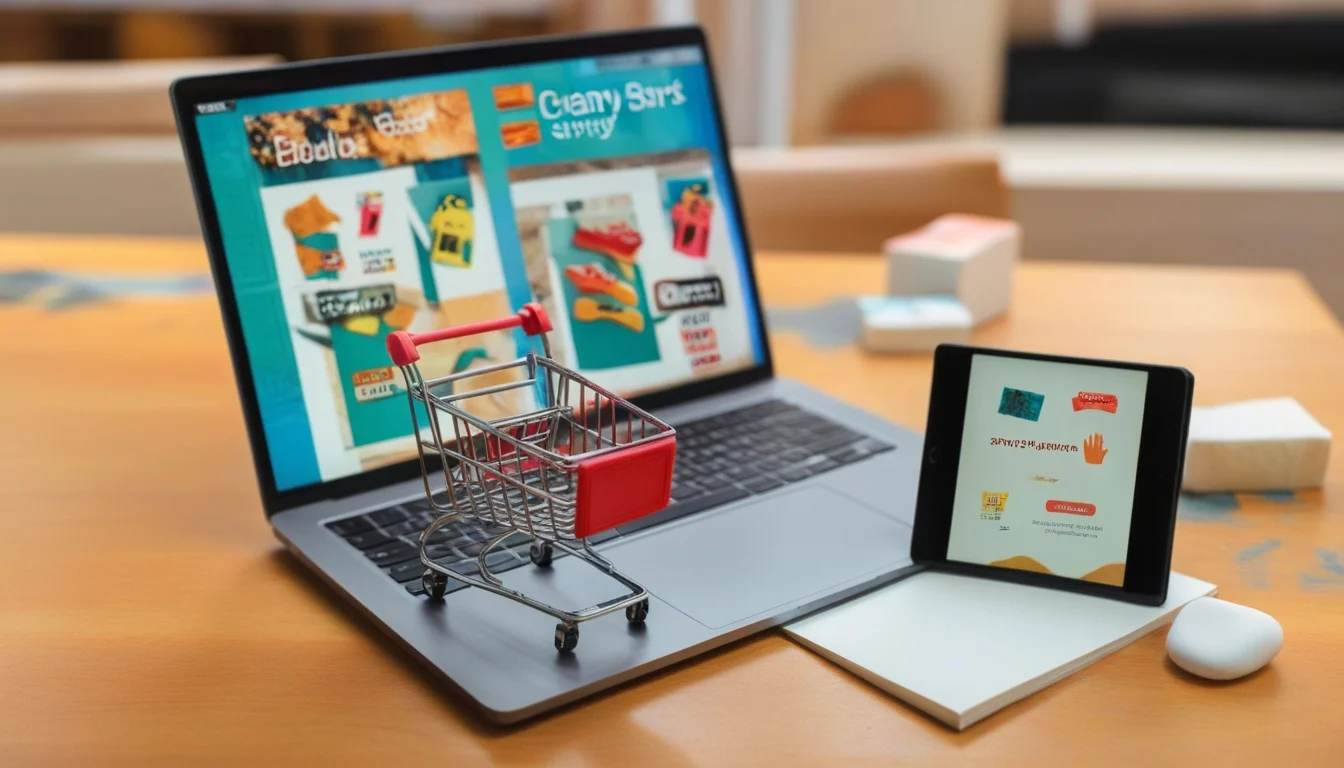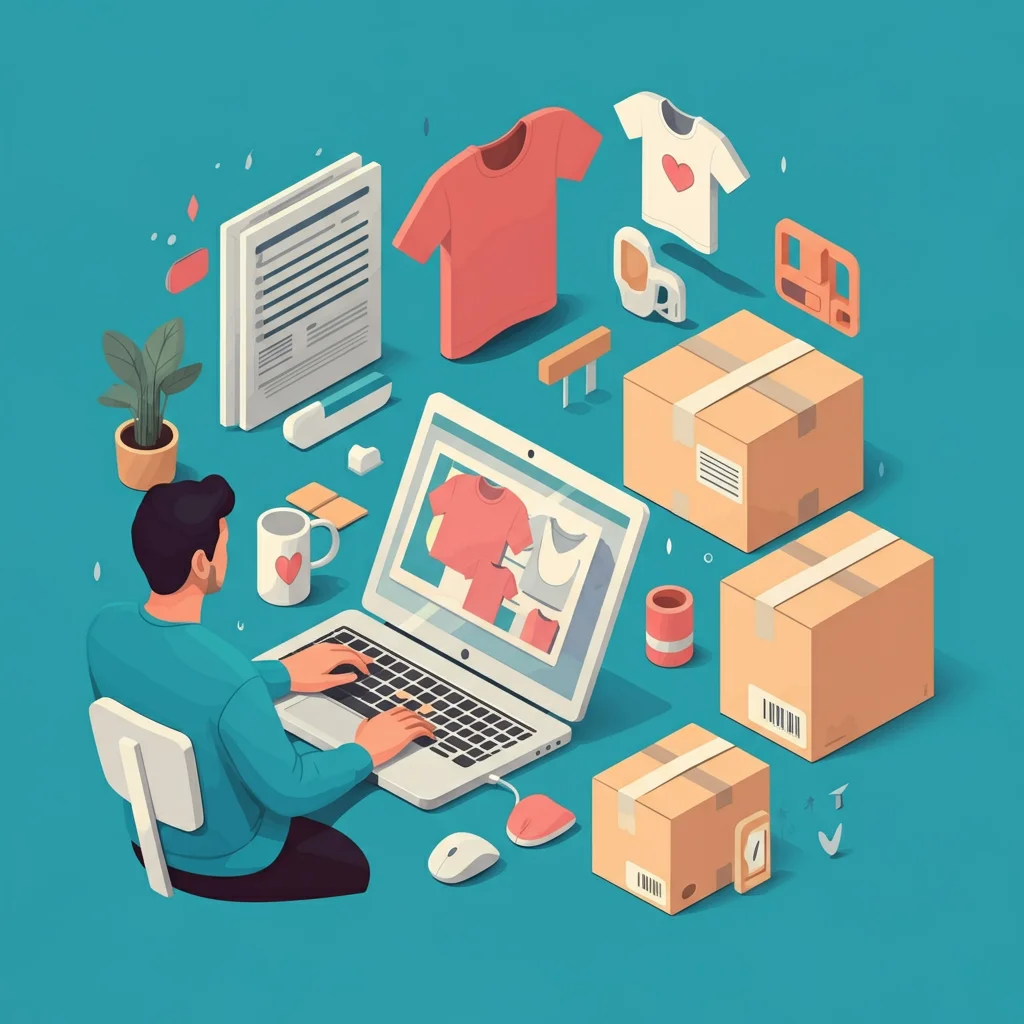Do you have aspirations to establish your own prosperous e-commerce enterprise, but are you hindered by worries about manufacturing, handling extensive inventory, or encountering high initial expenses? Print-on-demand (POD) and dropshipping offer revolutionary, low-risk pathways to sell custom products online and make money without ever touching a single item of stock. These agile business models have fundamentally reshaped the world of online retail, empowering aspiring digital entrepreneurs to launch profitable ventures with minimal initial investment.
This comprehensive guide will break down precisely how print-on-demand and dropshipping work, providing you with a step-by-step roadmap to get started. From meticulously selecting reliable suppliers to seamlessly setting up your compelling online store and implementing powerful marketing strategies for your unique products, you’ll gain the essential knowledge to build a successful and scalable e-commerce business.
What You'll Discover in This Guide:
This guide will reveal the crucial distinctions and similarities between print-on-demand and dropshipping.
These models offer compelling benefits that make them ideal for starting an online business with low upfront costs.
This guide includes expert tips for choosing the perfect suppliers that are tailored to your specific niche.
This guide provides a practical approach to setting up and branding your professional online store.
Proven strategies to effectively market your custom products and drive sales.
Learn how to track performance and enhance your business for ongoing expansion.
Understanding the Core: Print-on-Demand vs. Dropshipping
Before diving into the "how-to," let’s clearly define these two powerful e-commerce models:
1. Print-on-Demand (POD): Sell Your Custom Creations with Zero Inventory

Print-on-demand is a business model that allows you to sell custom-designed products only after a customer places an order. This means no inventory, no wasted stock, and maximum creative freedom.
How it Works (The POD Workflow):
You Design: You create unique designs (graphics, text, artwork) for various products like T-shirts, hoodies, mugs, phone cases, posters, tote bags, and more.
You list: You upload these designs to a print-on-demand platform (your supplier) and create mockups to display on your online store.
Customer Orders: A customer visits your e-commerce store and purchases a product with your design.
Your chosen print-on-demand partner receives the order details either automatically or manually.
Production & Shipping: The POD partner produces (prints, embroiders, etches) that specific product, packages it, and ships it directly to your customer under your brand.
This setup empowers you to focus purely on creativity, branding, and marketing, while a third party handles all the complex production, inventory management, and shipping logistics. It's an ideal way to sell custom products online and truly make money from your artistic vision.
2. Dropshipping: Sell Ready-Made Products Without Stocking Inventory

Dropshipping, on the other hand, allows you to sell ready-made products without ever having to purchase or hold physical inventory yourself. Instead, you partner with dropshipping suppliers who maintain the inventory and ship the products directly to your customers.
How it Works (The Dropshipping Workflow):
You list products from a dropshipping supplier's catalog on your online store, adding a markup to the prices.
Customer Orders: A customer places an order for a specific product in your store.
You Forward Order: You then purchase that product from your supplier at a wholesale price, providing them with the customer's shipping details.
Supplier Ships: The supplier fulfills the order by packaging and shipping the item directly to your customer.
Popular dropshipping products encompass a wide range, including trending apparel, unique gadgets, beauty items, specialized home goods, and electronics. Many online retailers use platforms like Al The Shared Advantage: Both print-on-demand and dropshipping models fundamentally eliminate the need for large upfront inventory investments and remove the burden of managing storage, packing, and shipping logistics, making them perfect for starting an online business with low upfront costs.
Remove the burden of managing storage, packing, and shipping logistics—making them perfect for starting an online business with low upfront costs.
Why Choose Print-on-Demand or Dropshipping? The Benefits Unpacked
T The surge in popularity of these models is intentional. They offer compelling advantages for aspiring entrepreneurs:
Remarkably low startup costs:
Similar to traditional retail, where you purchase significant stock upfront, these models are revolutionary because you only pay your suppliers or printers after a sale is made. T This approach dramatically reduces financial risk and eliminates the need for a large capital investment, making it accessible to virtually anyone looking to start an online business.
Unparalleled Flexibility and Scalability:
You can operate a print-on-demand or dropshipping business from any location globally, as long as you have an internet connection. You set your hours, automate many processes, and can exponentially scale up your product offerings without ever dealing with storage limitations or the physical constraints of inventory.
Zero Inventory Headaches:
Say goodbye to the hassle of managing warehouses, tracking stock levels, packing individual orders, and handling shipping labels. With POD and dropshipping, trusted third-party suppliers and printers manage all the complex logistics, allowing you to dedicate your valuable time to what truly grows your business: product development, marketing, and customer relationships.
Effortless Product Testing:
Are you interested in testing a new design idea for a custom product or exploring the market for a trending dropshipping product? These methods enable you to experiment without incurring financial risk. If a product or design doesn’t sell as expected, you can simply remove it from your online store, which means there is no wasted money on unsold inventory. This agility significantly transforms the landscape for entrepreneurs.
How to Start Your Print-on-Demand or Dropshipping Business: A Step-by-Step Roadmap
Launching a profitable e-commerce business in either the print-on-demand or dropshipping sectors is more accessible than you might think. Follow these clear steps to transform your idea into a successful reality.
Step 1: Discover and Define Your Niche

This process This step is perhaps the most crucial first step. Start by identifying a specific niche market that genuinely excites you and, importantly, shows clear demand.
Passion Meets Profit: If you choose print-on-demand, consider focusing on designing humorous T-shirts for cat lovers, unique merchandise for indie gamers, or empowering apparel for female entrepreneurs. If you are considering dropshipping, you might be interested in innovative smart home gadgets, sustainable beauty items, or ergonomic office supplies.
Market research is key.
Google Trends: This tool allows you to see how popular a topic has been over time and across different regions.
Exploding Topics: Discover emerging trends before they become mainstream.
Social Media: Explore popular hashtags on Instagram, TikTok, and Pinterest to understand which communities are actively engaging with them.
Online Marketplaces: Browse Etsy, Amazon, and competitor stores to identify bestsellers and areas that are underserved.
Focus on Solutions or Communities: Target products that address a specific problem, appeal to a dedicated hobbyist community, or correspond with a prominent lifestyle trend. A A defined niche makes marketing much more effective and helps your business stand out.
Step 2: Select the Right Suppliers—Your Business Backbone
Y The supplier or suppliers we choose will serve as the operational backbone of your print-on-demand or dropshipping business. A A great supplier ensures product quality, competitive pricing, fast shipping times, and reliable customer service—all of which are crucial for your brand's reputation.
For Print-on-Demand (POD):
Key factors to consider include diverse product catalogs, high print quality, global fulfillment centers (which enable faster shipping to international customers), competitive pricing, integration with your e-commerce platform, and excellent customer service.
Here are some popular Here are some popular POD platforms to explore for your research:
Printful is known for offering a wide variety of high-quality products and providing global fulfillment services.
Rintify offers a vast network of print providers, which allows users to compare prices and quality for identical products.
Ooten offers flexible pricing and extensive options for product customization.
For Dropshipping:
Key factors to look for include reliable inventory, quick processing and shipping times (especially from US/EU suppliers), competitive wholesale pricing, quality product images and descriptions, and strong communication.
Popular Dropshipping Supplier Platforms (for research):
AliExpress offers t There are thousands of products available at very low wholesale prices; however, these products often have longer shipping times. This platform is ideal for initial testing.
Pocket focuses on high-quality suppliers, primarily from the US and EU, which leads to faster shipping.
Zendrop: Designed specifically for dropshippers, featuring faster shipping, US warehousing, and a user-friendly interface.
Step 3: Set Up Your Online Storefront

Y Your online store serves as the home for your brand. The next step is to build this digital storefront where customers can discover and purchase your products. Most digital entrepreneurs find that e-commerce platforms like Shopify are the most user-friendly and robust choices because they offer seamless integrations with most print-on-demand (POD) and dropshipping suppliers.
Key Elements for Your Store:
Homepage: Make a strong first impression. Clearly articulate your unique selling proposition, showcase your bestsellers, and highlight any current promotions.
Product pages are critical for conversions. Include high-quality product images, detailed descriptions that highlight benefits, clear pricing information, and compelling calls to action.
About Us Page: Share the story of your brand. T This approach builds trust and connects with your audience on an emotional level.
Contact Us Page: Provide clear ways for customers to contact you, such as through email or a contact form.
FAQ Page: Address common questions about shipping, returns, and product care.
Policies: Clearly display the shipping, return, and privacy policies.
Branding is Essential: Go beyond just setting up pages. Create a memorable logo, choose a cohesive color scheme and fonts, and write engaging copy that reflects your brand's personality while resonating with your target audience. A A strong brand helps you stand out in a crowded market.
Step 4: Create Winning Product Listings
Your product listings serve as the foundation of your store's appeal. They are what convinces customers to make a purchase.
Compelling titles should include keywords that your target audience is likely to search for. Be descriptive and intriguing.
Benefit-Oriented Descriptions: Don't just list features; explain how the product benefits the customer. What problem does it solve? What desire does it fulfill? Use compelling storytelling.
High-Resolution Images: For dropshipping, use the best quality images provided by your supplier. For print-on-demand, use professional mockups that are often provided by your POD platform, or create your own using tools like [suspicious link removed] or Placeit to showcase your designs on realistic product examples.
Social Proof: Integrate customer reviews and testimonials as soon as you begin to make sales.
Step 5: Market Your Products Like a Pro

Once your online store is live, it’s time to attract customers! Successful marketing is essential for driving traffic and increasing sales in your e-commerce business.
Social Media Marketing:
Platforms such as Instagram, Pinterest, and TikTok are excellent for showcasing visually appealing products. Facebook is still strong for community building and targeted advertising.
Content: Share high-quality lifestyle photos and videos showcasing your products in use, provide behind-the-scenes glimpses of your design process (for POD), include customer reviews, and post engaging content related to your niche.
Engagement: Actively interact with your audience, respond to their comments, and utilize relevant hashtags.
Paid Advertising (Start Smart):
Use targeted Facebook, Instagram, or Google Ads to reach your ideal audience. Start with a small budget, test different ad creatives and audience segments, analyze performance metrics such as cost per click and conversion rate, and only scale the campaigns that are successful. Paid ads can provide rapid traffic, but they require careful management.
Email Marketing:
Build Your List: Offer a lead magnet, such as a discount code or a free guide, to encourage visitors to sign up for your email list.
Engagement: Send regular, valuable emails. Announce new arrivals, offer exclusive discounts, share useful content related to your niche, and subtly embed affiliate links to relevant products.
Influencer Collaborations:
Partnerships: Identify and collaborate with micro-influencers who have between 1,000 and 50,000 followers in your niche. They often have highly engaged audiences and are typically more affordable than mega-influencers. They can showcase your products authentically, which drives traffic and sales.
Step 6: Monitor, Analyze, and Optimize for Continuous Growth

Launching is just the beginning. To ensure that your print-on-demand or dropshipping business thrives, you must continuously track your performance, analyze data, and refine your strategies.
Use Analytics Tools: Leverage tools such as Google Analytics (for website traffic insights), the built-in analytics of your e-commerce platform (Shopify has excellent reporting), and metrics from specific ad platforms.
Key Metrics to Monitor:
Website Traffic: How many visitors are coming to your online store?
Conversion Rate: What percentage of visitors actually make a purchase? (This is crucial!)
Average Order Value (AOV): What is the typical amount customers spend per order?
C The cost of acquiring a new client is known as the customer acquisition cost, or CAC.
Profit Margins: Ensure that you are pricing your products competitively while maintaining healthy profit margins after accounting for supplier costs, platform fees, and marketing expenses.
Iterate and Improve: Based on your data, update your product offerings by removing underperformers and adding new bestsellers, refining your product listings, tweaking your marketing campaigns, and experimenting with pricing strategies. Customer feedback is invaluable here.
Understanding the Risks: What to Watch Out For Although print-on-demand and dropshipping require minimal upfront investment, they present several challenges:
Supplier Dependence: Your entire business relies on your supplier's quality, shipping speed, and reliability. A bad supplier can damage your brand.
Mitigation: Thoroughly vet suppliers, order samples to check quality, read reviews, and ideally have backup suppliers.
Profit Margins: In the dropshipping model, competition can lower prices, which negatively affects your profit margins.
Mitigation: Concentrate on establishing a strong niche, developing a powerful brand, providing unique value, and considering higher-ticket items or bundles.
Shipping Times and Customer Expectations: In dropshipping, particularly when sourcing from international suppliers such as AliExpress, shipping durations can be lengthy, which may result in customer frustration.
Mitigation: Clearly communicate shipping times upfront, consider using suppliers with faster shipping options (e.g., US/EU-based), and effectively manage customer expectations.
Customer Service Responsibility: As the store owner, you are responsible for customer service, even if the supplier is in charge of shipping.
Mitigation: Ensure responsiveness, proactively communicate updates, and establish clear return/refund policies.
Competition: The low barrier to entry results in increased competition.
Mitigation: Strong branding, unique niche selection, superior customer service, and effective marketing are your differentiators.
Build Your E-commerce Dream Business Today!
Starting your e-commerce business doesn't have to be daunting or require a massive upfront investment. With the strategic power of print-on-demand and dropshipping, you can create a successful venture from the comfort of your home, outsourcing the complex production and fulfillment logistics to trusted partners.
These innovative models empower you to focus your energy on what truly differentiates your brand: creativity, compelling design, savvy marketing, and building strong customer relationships. You can accomplish this while managing an adaptable, expandable, and potentially lucrative online store.
Are you ready to turn your e-commerce dream into a tangible reality and start making money online? Take the crucial first step today by deeply researching your chosen niche, or sign up for starter accounts on platforms like Printful, Printify, or Spocket to explore their offerings. With the right tools, a dedicated mindset, and a commitment to learning, your online business can absolutely thrive in no time!



